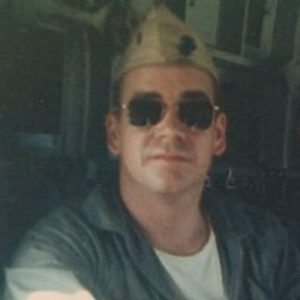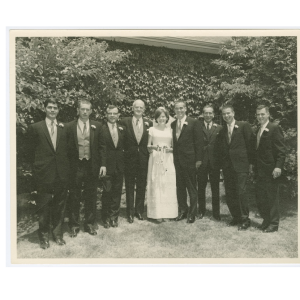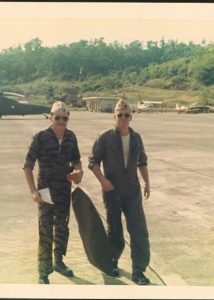
Michael J. Carley ’62
(1st Lieutenant, U.S. Marine Corps, 1964–1967. Killed in action, Nui Dang, Vietnam, February 27, 1967.)
Most young men were still angling for their drivers’ licenses when 16-year-old Michael John Carley helmed his first flight as a licensed pilot. While he remained close with his parents, brother, and two sisters throughout his life, Mike spent most of his childhood at elite boarding schools in Western Connecticut, winning scholarships to attend first the Indian Mountain School, then Hotchkiss School. During his sophomore year of high school he earned his pilot’s license, and senior year, Mike accepted an ROTC scholarship to attend Brown University, ensuring he’d have a future up in the air.
Mike arrived on Brown’s leafy campus in the fall of 1958. He became known as a nice guy with swagger—confident, bright, athletic, and charming. Socially, Mike stayed close with longtime boarding school,but he also made friends with his brothers in fraternity Alpha Delta Phi, and with his teammates on the hockey field. A star player, Mike looked up to his hockey coach so much that he would later remember Coach Fullerton’s rousing pep talks on a tape sent home from Vietnam, his voice warm for the memory.
“He had a lot of bravado,” remembers his widow Connie Worthington, “but was such a kind person that you saw that as well as the—the collegiate sort of guy. And it turns out that he just loved Brown.” Mike was preparing for his last semester at Brown when he met Connie Worthington on a hazy night in the summer of 1963. The two were guests at a party in Bristol, Rhode Island, and introduced by mutual friend Bill Twaddell. Connie, a Providence native, was about to start her sophomore year at Mount Holyoke. When Bill introduced the two, the connection “was immediate, overpowering, wonderful,” Connie remembers. “He had asked me to marry him the night we met, when he was not in a state to ask anyone to marry,” she laughs.
On their first date some days later, Mike insisted on taking Connie flying. “That was one of the things that I loved about Mike,” says Connie. “He wanted me to see what he loved right away. There wasn’t much guile in him.” By January of 1964, when Mike finally completed his degree in Sociology, the two were engaged to be married. After returning from his mandatory stint at Officer Candidate School in Quantico, Virginia in order to fulfill his NROTC contract, Mike returned in the late spring and the couple married on June 6, 1964. After the ceremony, guests gathered in the oaken-walled Brown Faculty Club for a reception hosted by Connie’s parents. The next day, the two headed south for flight training.

Mike’s training came with extensive moving around, and their first stop was the major naval air base in Pensacola. In the fall of 1964, after Mike had made first lieutenant at Pensacola, the Carleys headed east to a small auxiliary base in Milton, Florida for air carrier training. On November 7, in a civilian hospital in Avalon Beach, the couple welcomed Mike Jr. From Milton, the Carleys moved to another naval auxiliary base in Pace, FL, before transferring to Marine Corps Base Camp Lejeune, which sprawled over 250 square miles of land in coastal Onslow County, North Carolina. They would remain there from the spring of 1965 until Mike was called to Vietnam the following year.
The Carleys flourished at Camp Lejeune. “In that squadron Mike really came into his own,” Connie remembers. “He’d always felt like the scholarship kid, that everybody had done him charitable favors…. The thing that we both loved about the Marine Corps was you got where you were for what you yourself did for the Corps, for the squadron—the quality of your work, the quality of your participation and leadership.”
Mike received his call of duty to Vietnam in the spring of 1966. With a month off before he was scheduled to deploy, Mike, Connie, and 18-month-old Mike Jr. headed back to the Chepachet cabin where they had spent their wedding night. Connie remembers having “lots of discussions, and ‘what if’ conversations” with Mike. An entire year had passed since the fall of Saigon, and everyone understood that Mike might not make it home. “Other families sent their men off into war zones and hadn’t expected that anything might happen to them,” Connie says. But she and Mike were pragmatic, deciding that if something happened to Mike in the service, she’d go back to school, get her degree, and rely on her parents’ help to raise Mike Jr. “It’s just the path that I had chosen by choosing Mike,” Connie says. “Not that I felt like I had any choice.” The frank talk allowed them to relax and enjoy what would be their last weeks together in Rhode Island. In June of 1966, Mike flew to Camp Pendleton to prepare for deployment to Vietnam.
In country, Mike was assigned to HMM-362, a helicopter squadron distinguished for being the first Marine aircraft unit to serve in Vietnam. Known as the Ugly Angels, Mike’s squad flew Sikorsky H-34Ds, heavy, bottle-nosed birds designed to accommodate transport of troops and equipment in all weather conditions, although they became best known for their medevac missions. Mike joined the Ugly Angels at Ky Ha, a small base near Chu Lai in Quang Tin Province within the I Corps Tactical Zone, a swath of American-occupied land in the northernmost region of South Vietnam.
Mike sent regular letters and audio recordings home, cooing to his son and telling Connie and their family about his missions and life in the camps. He spoke about the beauty of the country, the wonder of seeing Da Nang’s Monkey Mountain, and the “important work” that CARE, an antipoverty NGO, was doing for Vietnamese children in his area. In his very first month, Mike flew wing to the helicopter carrying John Wayne when the movie star made one of his well publicized tours of support. It was also the month that he saw his first tragedy. “A friend of his from training was killed by friendly fire, and he was so angry, so angry,” says Connie. Mike said that it “‘shouldn’t have happened.’”

Connie would get to see Mike one last time, for a Hawaiian R&R at the end of January 1967. (They had been scheduled to meet that March, but another soldier dropped out at the last minute.) With Mike Jr. safely in her parents’ care, Connie packed a bag and boarded a plane for Honolulu. “I was really worried about the R&R,” she admits, “Because I had been on a college campus that was mobilizing against the war, and he had been in a war zone. And I was afraid that we might have grown apart somehow.” Although Connie would only join the antiwar movement until after Mike’s death, protests had already begun on Brown’s campus. She was relieved, though, to find that nothing had changed between her and Mike: “The minute we got together, it was still the same old, same old. I mean, it was just wonderful that we’d had such totally different experiences, which we talked about, but it was just great.”
“We blew a lot of money, we ate a lot of wonderful meals, took a lot of long walks,” Connie recalls. “We rented a car one day and drove around, so we ended up in pineapple fields, and so on.” For Mike and Connie, the five days of R&R were idyllic. “And then he left at the crack of dawn,” Connie remembers, “and I saw him off and came back to the hotel.” After Mike returned to Ky Ha, “We were back to the norm,” says Connie. “I was almost sure when he went to Vietnam first that he wasn’t going to come back,” she remembers. But something about seeing Mike again allowed her to relax. “I was convinced he was coming back after the R&R….I was absolutely sure everything was going to be fine.”
Less than three weeks later, in the afternoon of February 27, 1967, Captain Jim Hippert led a team of Angels on a mission to transport troops and supplies some 55 miles south to Duc Pho. Hippert flew lead with Mike as copilot. The Angels rose up into a thick grey rain and the bleak weather forced the team to fly low, hovering just above the treetops. As they curbed left to make an eastward descend into Nui Dang, Mike’s helicopter was hit hard with small arms and .50 cal gunfire. Enemy rounds pierced the front windscreen, hitting Mike in the face and Hippert in the leg. By the time Hippert wrestled the bullet-riddled bird onto the muddy ground, Mike was dead.
When a black car pulled up to the door of her parents’ home, Connie was watching Mike Jr. color at the kitchen counter. A priest got out, then a uniformed Marine. “The doorbell rang and you knew as they got out of the car what had happened,” Connie says. The priest was from St. Sebastian’s, and the Marine was Second Lieutenant John Marshall, the casualty officer assigned to the Carleys. The men didn’t know much, only that Mike had been killed in action. “I just was stunned. Just stunned,” Connie says. “I didn’t fall apart. I just remember sitting there, looking at my shoes and at their feet. And then, after a little bit, I thought, ‘Where is Little Michael?’ He came out from the kitchen, took off one red sneaker and threw it at John Marshall, took off the other red sneaker and threw it at the priest and laughed. And life went on.”

And life did go on, but it was not the same. “I have always said to people that that was the turning point in my life” says Connie. “That was the event that changed everything, and still dominates it….I will always be a Vietnam widow. It always defines me.” Mike’s death marked a turning point in Connie’s political and personal life. Brutal footage of the war kept streaming into American living rooms, and the antiwar movement gathered strength as the conflict intensified. Connie joined the antiwar protests on Brown’s campus, and in the fall of 1968 and again in December of 1969, Connie published articles in support of the protest movement in the magazine of the Providence Junior League. “It became a different war after his death,” she reflects.
Though he never enlisted, Mike Jr., who lives with Asperger’s, has travelled with American Veterans (AMVETS) and Veterans for Peace to complete postwar service projects in Iraq, Cuba, and Bosnia. Now in his 50s, Mike Jr. has kept in touch with the Carleys and some of his father’s Marine Corps friends, even attending Ugly Angels reunions.
Much of Connie’s life has been defined by Mike’s death. “That’s the event that changed everything, and still dominates it,” she says. “It won’t disappear. Yes, time has healed the wounds, but I don’t want the world to go to war.” Connie and her husband, a Brown professor, continue to make their home in Rhode Island. “I couldn’t ask for a better partner in life. But I will always be a Vietnam widow. It always defines me.
